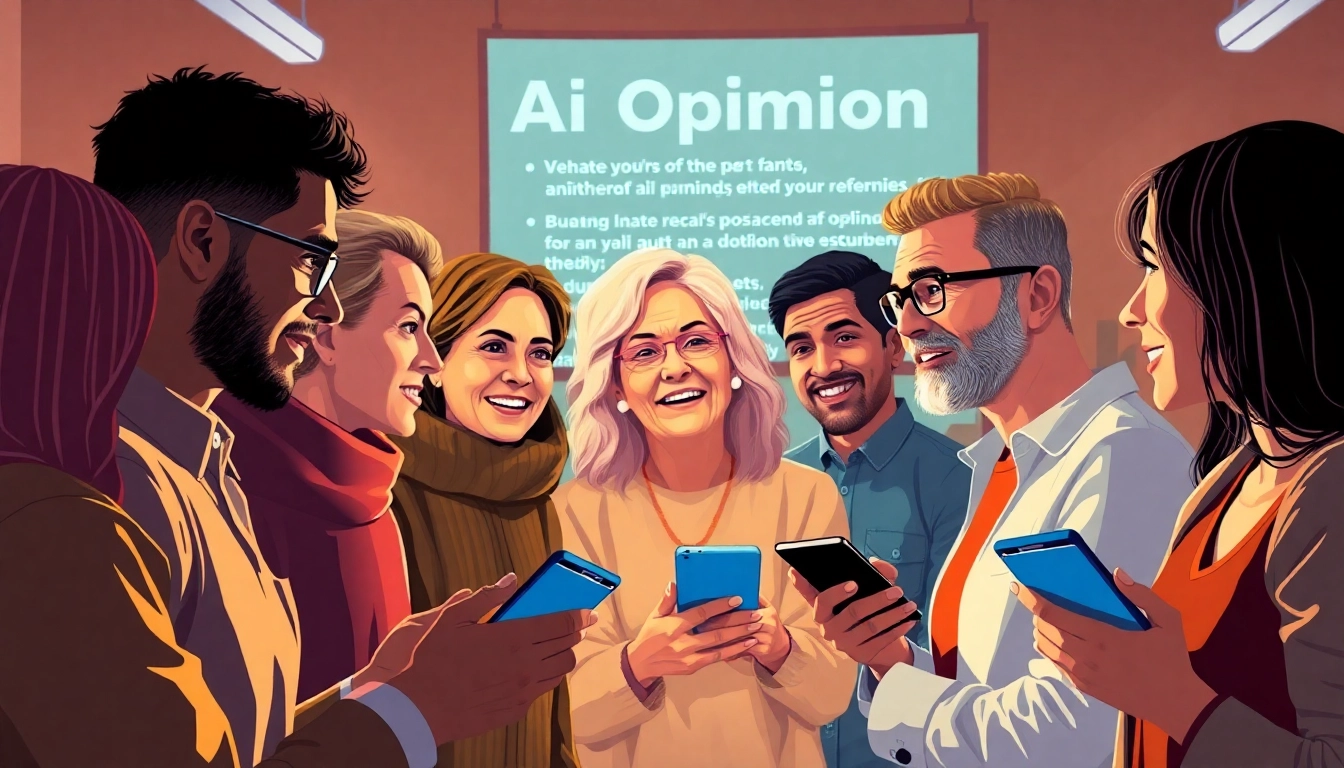Understanding Public Sentiment: Insights from Recent AI Opinion Poll Results
Introduction to AI Opinion Polling
Understanding public sentiment regarding artificial intelligence (AI) is both essential and complex. As AI continues to infiltrate various sectors—from healthcare to finance—accurate insights into how individuals perceive this technology can guide its development, regulation, and implementation strategies. An AI Opinion poll serves as a nuanced tool to capture these sentiments, allowing businesses, policymakers, and technologists to align their strategies with public expectations and concerns.
What is an AI Opinion Poll?
AI opinion polls are structured surveys designed to gauge the views of the public on the adoption, implications, and future of AI technologies. These polls are critical for assessing not just popularity but also the apprehensions and aspirations surrounding AI. The data collected can reveal how various demographics perceive AI’s role in their lives, its potential risks, and the benefits they anticipate. Typically, these polls include targeted questions regarding specific AI applications—like automation, intelligent assistants, and autonomous vehicles—enabling a thorough understanding of public sentiment across multiple facets.
The Importance of Public Sentiment on AI
Public opinion serves as a barometer of sentiment regarding AI technologies. Understanding this sentiment is pivotal for several reasons:
- Development Focus: Insights from polls can guide developers on what features or ethical considerations to emphasize in AI systems.
- Building Trust: Addressing public concerns revealed through polls can help instill greater trust in AI technologies.
- Policy Formulation: Governments can craft regulations that reflect public sentiment, ensuring societal needs and ethical standards are met.
How Polls Influence AI Development
Surveys and polls offer reflective data that not only indicate current public feelings but also predict future trends and behaviors. Many technology firms actively use these insights to align product development with customer expectations, ensuring higher acceptance rates. For example, if a poll suggests that the public fears job displacement due to AI, companies may choose to highlight features that create jobs or enhance human productivity rather than automation. Therefore, polls play a crucial role in steering the direction of AI innovation.
Current Trends in AI Public Opinion
Key Findings from Recent Surveys
Recent polls have unveiled several startling trends about public opinion regarding AI:
- According to a Pew Research Study, 52% of Americans express more concern than excitement about AI in their daily lives, while only 10% feel the opposite.
- Additionally, a recent Gallup poll indicated that the majority see more harm than good arising from AI, particularly fears relating to job losses and data privacy.
- A YouGov survey found that 40% of Americans perceive AI as potentially harmful to societal structure, a notable uptick from previous years’ results.
Demographic Variations in AI Perspectives
The perception of AI is not uniform across demographics. Research shows that:
- Women generally express higher levels of skepticism toward AI than men, especially concerning privacy and security.
- Younger adults show more enthusiasm and willingness to adopt AI technologies compared to older generations.
- Geographical differences also play a role; urban populations tend to embrace AI innovations faster than rural counterparts, reflecting differences in access and exposure.
Comparative Analysis with Past Opinions
When juxtaposed against earlier data, current polls indicate a growing skepticism and heightened concern about AI. For instance, in 2015, only 38% of people expressed concerns about AI, but recent assessments show rising apprehension about its implications. This change reflects broader societal anxieties, influenced by high-profile incidents of AI misuse, data breaches, and a growing awareness of ethical implications.
Concerns Surrounding AI Technology
Fear vs. Excitement: Public Sentiment Dynamics
The dichotomy of fear and excitement around AI is a significant theme in public opinion. While many recognize the potential for enhanced productivity and efficiency, a substantial portion of the population also harbors fears about privacy infringement, misinformation, and the loss of human jobs. For instance, a report showed that 72% of respondents were concerned about how AI might contribute to misinformation, showcasing the depth of public wariness.
Job Security and AI: What Polls Reveal
Job insecurity is one of the most pressing concerns cited in AI opinion polls. Respondents overwhelmingly worry that AI technologies will replace human roles, particularly in sectors like manufacturing, transportation, and customer service. Many surveys reveal that despite acknowledgment of AI’s benefits, a staggering 63% of workers fear job loss due to automation. This presents a challenge for AI advocates to not only develop technology but also advocate for upskilling and transitions to new roles, which could help alleviate such fears.
AI in Everyday Life: Mixed Reactions
As AI technologies become increasingly prevalent in everyday applications—from smart assistants to recommendation algorithms—public reactions remain mixed. Many users appreciate the convenience that AI brings to tasks like scheduling and shopping, yet a considerable fraction feels uncomfortable with the level of data collection involved. Ongoing discussions about ethical AI use and consumer protection illustrate the need for ongoing dialogue between technologists, businesses, and the public.
Implementing Insights from AI Polls
For Businesses: Navigating Consumer Concerns
Businesses are often on the frontlines when it comes to addressing public sentiment about AI. By implementing insights derived from opinion polls, companies can:
- Develop Consumer-Centric AI: Using feedback to shape products that prioritize user benefit and address specific concerns can lead to greater acceptance and use.
- Enhance Transparency: Offering insights into how consumer data is used can build trust and mitigate fears about privacy violations.
- Tailor Marketing Strategies: Campaigns can be designed to directly address public concerns, positioning AI as a tool for empowerment rather than replacement.
Policy Implications: Shaping AI Regulations
Understanding public sentiment is invaluable for policymakers as they navigate the complex landscape of AI regulation. Poll insights can guide the formulation of legislation aimed at protecting consumers while encouraging innovation. Policymakers can address pressing issues like ethical AI use, data privacy safeguards, and job transition programs by leveraging public feedback, ultimately leading to more public trust and cooperation.
Creating Awareness: Educational Initiatives
As AI technology evolves, creating awareness through educational initiatives becomes vital. Communities can benefit from educational programs designed to demystify AI and provide insights into how it operates and affects daily life. Initiatives can focus on:
- Workshops that explain AI basics and its applications in various sectors.
- Public forums for discussing concerns and expectations surrounding AI technology.
- Collaboration with schools to integrate AI literacy into curricula, preparing future generations for an AI-integrated world.
Conclusion and Future Directions
Emerging Patterns: AI Opinion Trends Ahead
As AI continues to advance, emerging patterns in public opinion will likely shape the future of technology. Polls indicate that while acceptance may grow, the underlying concerns will require ongoing engagement. This dynamic means that stakeholders must actively listen to public sentiment and adapt accordingly. Trends related to regulatory support, ethical considerations, and improved consumer understanding will all play critical roles in shaping tomorrow’s AI landscape.
The Role of Technology in Shaping Future Polls
Future polls will benefit from advancements in polling methodologies and the use of AI-driven analytics. Tools that analyze vast datasets and sentiment can provide real-time insights into public sentiment, allowing for more responsive and adaptive strategies in AI product development and policy formulation. Initiatives leveraging machine learning can identify subtle shifts in public sentiment faster than traditional methods.
Call to Action: Engage with AI Discussions
Ultimately, engaging in discussions about AI—through forums, social media platforms, and community outreach—is essential. By actively participating in these dialogues, individuals can shape the narrative surrounding AI, ensuring that it aligns with societal values and collective public interests.













Post Comment